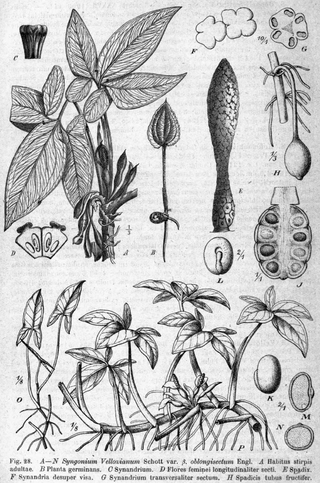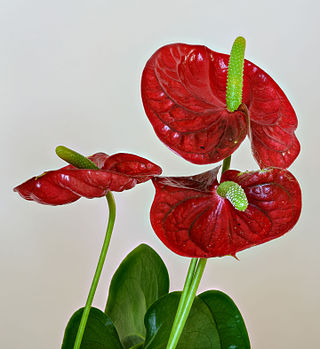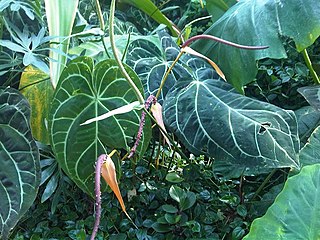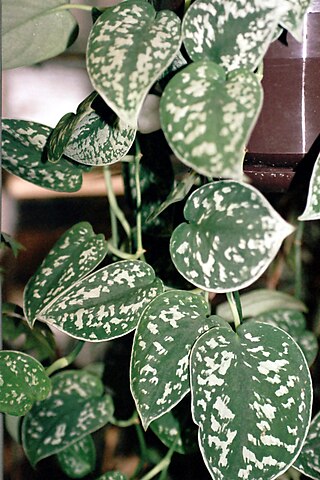
The Araceae are a family of monocotyledonous flowering plants in which flowers are borne on a type of inflorescence called a spadix. The spadix is usually accompanied by, and sometimes partially enclosed in, a spathe. Also known as the arum family, members are often colloquially known as aroids. This family of 114 genera and about 3,750 known species is most diverse in the New World tropics, although also distributed in the Old World tropics and northern temperate regions.

Epipremnum aureum, the Pearls and Jade pothos, is a species in the arum family Araceae, native to Mo'orea in the Society Islands of French Polynesia. The species is a popular houseplant in temperate regions but has also become naturalised in tropical and sub-tropical forests worldwide, including northern South Africa, Australia, Southeast Asia, Indian subcontinent, the Pacific Islands and the West Indies, where it has caused severe ecological damage in some cases.

Syngonium is a genus of flowering plants in the family Araceae, native to tropical rainforests in southern Mexico, the West Indies, Central and South America. They are woody vines growing to heights of 10–20 m or more in trees. They have leaves that change shape according to the plant's stage of growth, and adult leaf forms are often much more lobed than the juvenile forms usually seen on small house plants. The scientific name of the genus comes from the Greek words σύν and γονή and refers to the fused ovaries of female flowers.

Alocasia is a genus of rhizomatous or tuberous, broad-leaved, perennial, flowering plants from the family Araceae. There are about 90 accepted species native to tropical and subtropical Asia and eastern Australia. Around the world, many growers widely cultivate a range of hybrids and cultivars as ornamentals.

Anthurium is a genus of about 1,000 species of flowering plants, the largest genus of the arum family, Araceae. General common names include anthurium, tailflower, flamingo flower, pigtail plant, and laceleaf.

Furcraea foetida is a species of flowering plant native to the Caribbean and northern South America. It is widely cultivated and reportedly naturalized in many places.

Zamioculcas is a genus of flowering plants in the family Araceae, containing the single species Zamioculcas zamiifolia. It is a tropical herbaceous perennial plant, and is native to eastern Africa, including Kenya, KwaZulu-Natal, Malawi, Mozambique, Tanzania, and Zimbabwe. Its common names include Zanzibar gem, ZZ plant, Zuzu plant, aroid palm, eternity plant and emerald palm. It is grown as a houseplant, mainly because it has attractive glossy foliage and is easy to care for. Zamioculcas zamiifolia is winter-hardy in USDA Zones 9 and 10.

Nephthytis is a genus of five species of flowering plants in the family Araceae, native to tropical western and west-central Africa, ranging from Guinea to the Republic of the Congo.

Aglaonema is a genus of flowering plants in the arum family, Araceae. They are native to tropical and subtropical regions of Asia and New Guinea. They are known commonly as Chinese evergreens.

Acalypha hispida, the chenille plant, is a flowering shrub which belongs to the family Euphorbiaceae, the subfamily Acalyphinae, and the genus Acalypha. Acalypha is the fourth largest genus of the family Euphorbiaceae, and contains many plants native to Oceania.

Stephanotis floribunda syn. S. jasminoides, the Madagascar jasmine, waxflower, Hawaiian wedding flower, or bridal wreath is a species of flowering plant in the family Apocynaceae, native to Madagascar. It is a twining, sparsely branched liana that can measure up to 6 m in length.

Epipremnum is a genus of flowering plants in the family Araceae, found in tropical forests from China, the Himalayas, and Southeast Asia to Australia the western Pacific. They are evergreen perennial vines climbing with the aid of aerial roots. They may be confused with other Monstereae such as Rhaphidophora, Scindapsus and Amydrium.

Homalomena is a genus of flowering plants in the family Araceae. Homalomena are native to tropical Asia and China. Many Homalomena have a strong smell of anise. The name derives apparently from a mistranslated Malayan vernacular name, translated as homalos, meaning flat, and mene = moon.

Thaumatophyllum bipinnatifidum is a plant in the genus Thaumatophyllum, in the family Araceae. Previously it was classified in the genus Philodendron within subgenus Meconostigma. The commonly used names Philodendron bipinnatifidum and Philodendron selloanum are synonyms. This plant is native to South America, namely to Brazil, Bolivia, Argentina, and Paraguay, but is also cultivated as a landscape plant in tropical, subtropical and warm temperate climates.

Anthurium crystallinum is a species of flowering plant in the family Araceae, native to rainforest margins in Central and South America, from Panama to Peru. Growing to around 90 cm (35 in) tall and wide, A. crystallinum is an epiphytic perennial evergreen, known for its dark green and velvety-textured, heart-shaped leaves featuring prominent white veining, and somewhat resembles a smaller version of Anthurium magnificum. The inflorescence is a somewhat visually-nondescript spathe with a pale green spadix, appearing throughout the year.

Philodendron erubescens, the blushing philodendron or red-leaf philodendron, is a species of flowering plant in the family Araceae, native to Colombia. It is a robust evergreen climber growing to 3–6 m (10–20 ft), with red stems and heart-shaped leaves up to 40 cm (16 in) in length. The flowers are deep red, fragrant spathes up to 15 cm (6 in) long, in summer and autumn. The specific epithet erubescens means "blushing".

Scindapsus pictus—commonly called satin pothos, silver pothos, or silver vine—is a species of flowering plant in the aroid or arum family, Araceae, native to Bangladesh, Borneo, India, Java, Peninsular Malaysia, the Philippines, Sulawesi, Sumatra, Taiwan and Thailand. The Latin specific epithet pictus means "painted", referring to the variegation on the leaves.

Montrichardia arborescens, the yautia madera, or moco-moco, is a tropical plant grows along river banks, swamps, or creeks to a maximum height of 9'. They consist of arrow shaped leaves that are food sources for animal species. The plant produces inflorescences which then leave a fruit of Montrichardia arborescens which is edible and can be cooked. Its fruiting spadices produces large infructescences, which contain about 80 edible yellow fruits.

Thaumatophyllum xanadu is a perennial plant belonging to the arum family Araceae and the genus Thaumatophyllum, formerly classified under the Meconostigma subgenus of Philodendron. This plant is native to Brazil, but is widely cultivated as a landscape plant in tropical, subtropical and warm temperate climates.

Anthurium podophyllum is a species of plant in the genus Anthurium native to coastal areas of the Mexican states of Veracruz and Oaxaca. A terrestrial species, it grows in tropical forest understories in seasonally dry areas. It is named for its palmate leaves that somewhat resemble plants in the (unrelated) genus Podophyllum, and which have many subdivisions. It is related to other terrestrial Anthurium with similar leaf morphology in the section Schizoplacium, such as Anthurium pedoradiatum, and produces orange berries.

























